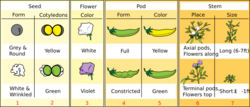Biology:Beanbag genetics
Beanbag genetics is a conceptual model of genetics which was used by early Mendelians, who used to keep coloured beans in bags as a way of tracking Mendelian ratios. The phrase was first coined by Ernst Mayr in describing the work of Ronald Fisher and J. B. S. Haldane who treated genes as independent entities to simplify their mathematical analysis of population genetics.[1]
To be able to understand beanbag genetics, the meaning of population has to change. A population is no longer a group of individuals in an area but rather the alleles in an area that assort and segregate separately. All of the alleles become the gene pool. When using the beanbag approach, there are two ways that the gene pool can be viewed. The first is to view the gene pool as all the alleles that represent all the traits in the population being viewed at once. The second is to view the gene pool as only the alleles for a single trait in the population. Once the alleles are chosen for the gene pool they are selected for at random. Mayr created the name beanbag because all the alleles were thought of as beans in a beanbag. The beanbag full of beans would be considered the gene pool for the population.
Studies
The paper 'Perils of “industrial gene” and “beanbag genetics”' written in 2008 by Dr. Lakhotia, discusses that biotechnology needs to be reassessed before continuing down the path that it is going down now. Dr. Lakhotia believes that overall everything in our genome needs to be looked at rather than just coding regions. We do know that our genetic material forms and organic system that is built by multiple smaller units working together. Since we know that multiple smaller units are used, scientists need to look at more than just the structural gene. We should look at the entire genome because know that even in the non-coding regions of our DNA is involved in the regulatory network.
Debate
The debate of BeanBag Genetics has been occurring for many years now. One thing scientists have agreed on is that BeanBag genetics is too simplistic and needs to be built upon. Sir Ronald Fisher and Sewall Wright are two scientist that were once a part of this debate. Fisher's assumptions were that: traits are determined by many loci with independent effects, populations are well mixed, and mating is random. Wright's assumptions were his Shifting balance theory that included: Random Drift, Individual selection, and Interdeme Selection. As both argue their theories, people agree with Fisher's theory because it works and is a well developed theory. Other people agree with Wright because his theory is closer to the real world and provides an aesthetically pleasing view of evolution. Even though both theories have parts that are right they both are wrong as well. Fisher's theory does not explain the diversity of the world and Wright's theory is just a metaphor not a well developed theory. So how do they know which theory is correct? Even though both theories are right and wrong, they both see a part of a larger picture.
Citations
- ↑ Dronamraju 2010, p. ix.
References
- Dronamraju, Krishna (2010), Haldane, Mayr, and Beanbag Genetics, Oxford University Press, ISBN 978-0199813346
- Crow, James F. "The beanbag lives on." Nature News. Nature Publishing Group, 15 Feb. 2001.
- Crow, James F. "Mayr, mathematics and the study of evolution." Journal of Biology. BioMed Central, 23 Feb. 2009. Web.
- Halane, JBS. "A Defense of Beanbag Genetics." Int J Epidemiol (2008) 37 (3):435-442. 01 Jun 2008
- Falk, R. "Between Beanbag Genetics and Natural Selection" Biol Philos (1990) 5: 313
- DE WINTER, W. "The Beanbag Genetics Controversy: Towards a synthesis of opposing views of natural selection. Biology & Philosophy (1997) 12: 149
- Lakhotia, Subhash C. "Perils of "industrial gene" and "beanbag genetics"." ResearchGate. Wiley InterScience, Mar. 2008. Web.
- Goodnight, Charles. "Evolution and the Genetics of Structured Populations." University of Vermont. Web.
- Provine, William B. "Ernst Mayr." Genetics. N.p., 1 July 2004. Web. 07 Mar. 2017.
- Froehlich, Jeffrey W., MArylin R. London, and Smithsonian. "Beanbag Population Genetics." N.p., 1996. Web. 7 Mar. 2017.
- Borges, Renee M. "Commentary: The objection is sustained: a defence of the defense of beanbag genetics." International Journal of Epidemiology. Oxford University Press, 1 June 2008. Web. 08 Mar. 2017.
External links
- https://anthropology.si.edu/outreach/Teaching_Activities/pdf/BEANBAG.96.pdf
- Shifting Balance
- "An Attack on BeanBag Genetics"


